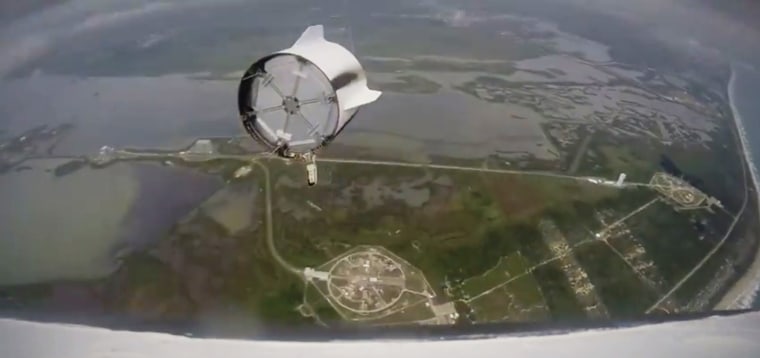SpaceX's Crew Dragon spaceship is being built to zoom astronauts out of harm's way in the event of a launch pad emergency — but based on newly released video that was captured during this month's pad abort test, it could be the kind of ride people would pay for, even if they're not going into space.
The May 6 test flight at Cape Canaveral Air Force Station in Florida marked the first on-the-pad trial for the Crew Dragon "pusher" system, powered by the next-gen capsule's eight SuperDraco thrusters. The Dragon accelerated from zero to 100 mph (160 kilometers per hour) in just 1.2 seconds and reached a top speed of 345 mph (555 kilometers per hour).
SpaceX's two-minute video, recorded by cameras mounted on the Dragon, shows the Florida landscape falling away as the craft rises about a mile (1.5 kilometers) above the pad. There are some thrilling moments as the Dragon slowly tumbles, the "trunk" separates and flies away, and the parachutes unfurl. Then there's a nice and easy drift down to the Atlantic.
The latest video doesn't show the splashdown, but you can watch that part of the ride at the end of a video that SpaceX released just a couple of days after the test.
So how would the ride feel? "Had there been people on board, they would have been in great shape," SpaceX's founder and CEO, Elon Musk, told reporters just after the test.
The only one who could contradict Musk on that score was the crash-test dummy that was strapped into the Dragon — and the dummy isn't giving interviews. For a true first-person account, we'll probably have to wait until 2017, when crewed tests of the Crew Dragon are due to begin.
The Boeing Co. is developing its own crew vehicle for NASA's use, known as the CST-100. Both companies are receiving billions of dollars from the space agency to support the projects, and they're expected to start flying NASA astronauts to the International Space Station in 2017.
IN-DEPTH
- SpaceX Dragon Capsule Splashes Down
- Dragon Pad Abort Test Is a Real Blast
- Here's What It's Like Inside SpaceX's Dragon Capsule

